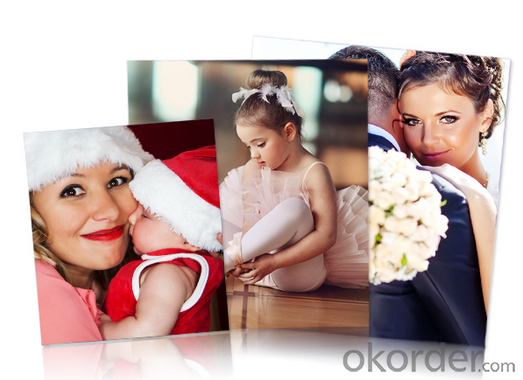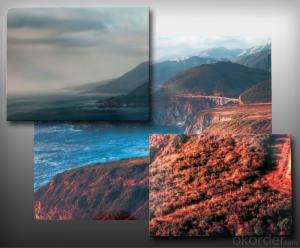Supplier Aluminium Metal Art Pictures Print On HD Aluminium Metal Panel
- Loading Port:
- Shanghai
- Payment Terms:
- TT OR LC
- Min Order Qty:
- 500 carton
- Supply Capability:
- 20000 carton/month
OKorder Service Pledge
OKorder Financial Service
You Might Also Like
Item specifice
Description:
These Aluminum Panels can provide for many sizes and different color. It can suitable in many occasion, like company logo screen, show backdrop, home use, some gift use etc. We can also provide the heat press machine for transferring.
Features:
1. Extremely durable scratch resistant surface that is waterproof and can be cleaned easily with a damp cloth.
2. Eco-friendly & Terrific as a decoration.
3. Longest lasting photo medium in the current market.
4. The high definition, vibrant colors coupled with superior fade, moisture, stain & scratch resistant properties.
5. The image is infused into the coating to provide permanent protection and durability.
6. Excellent choice for commercial, fine art, and home decoration applications.
Making Process:
1. Get images from digital camera, memory card or scanner.
2. Print image with heat transfer paper and sublimation ink.
3. Lay down a teflon sheet and your panel, and another CLEAN teflon sheet on top, pre-press for 60 sec., 180℃, 0.3Mpa.
4. 60 seconds later. Wait the panel to cool.
5. Tape the transfer to the face of the substrate with heat resistent tape running parallel to the edge of the substrate.
6. Lay substrate face up, transfer on top on a piece of telfon sheet on lower platen.
7. Cover with one layer of fabric, preferably 100% polyester or poly-silk, to distribute pressure and reduce stress on the coating.
8. Press for the prescribed time is 130sec., temperature is 180℃ and pressure is 0.3Mpa.
9. When finished, remove the fabric and gently peel the taped transfer off the substrate without allowing it to slide or move.
10. Let the substrate to cool. Do not handle it until cool to reduce the chances of damaging the coating on the edges.
11. Enjoy your personal designed aluminum board!


Free sample is OK
- Q:What are the different methods of polishing aluminum sheets?
- Polishing aluminum sheets can be done through various methods, each with its own pros and cons. Here are some commonly used techniques: 1. Manual polishing: By employing sandpaper or abrasive pads, one can manually rub the surface of the aluminum sheet to achieve a high level of shine and smoothness. However, this method demands physical effort and can be time-consuming, especially for larger sheets. Careful execution is crucial to avoid leaving behind scratches or marks. 2. Chemical polishing: Dissolving a thin layer of the aluminum surface using chemical compounds can result in a smoother and shinier finish. This method is suitable for larger sheets or complex shapes where manual polishing is impractical. However, chemical handling must be meticulous, and it may not be suitable for certain aluminum alloys. 3. Electropolishing: An electrochemical process involving the use of an electric current to remove a thin layer of material from the aluminum surface. This method guarantees a smooth and shiny finish for both small and large sheets. It is particularly effective in eliminating surface imperfections and achieving a uniform appearance. However, specialized equipment and expertise are required to properly control the process. 4. Vibratory finishing: Placing aluminum sheets in a vibratory machine with abrasive media, like ceramic or plastic chips, can help remove surface imperfections and achieve a polished finish. This method is ideal for large batches of sheets and can be cost-effective. Nevertheless, it may not produce the same level of shine as other methods. 5. Buffing and polishing compounds: These compounds are applied to the aluminum sheets and then buffed using a rotary tool or polishing machine. The abrasive particles in the compounds aid in removing scratches and enhancing the metal's shine. This method is relatively quick and easy, but it may not be as effective for significant oxidation or deep scratches. Ultimately, the choice of polishing method depends on factors such as the size and type of the aluminum sheets, desired level of shine, and available equipment and expertise. It is advisable to test different methods on a small area before proceeding with the full polishing process to ensure satisfactory results.
- Q:What is the hardness rating of 101 aluminum sheets?
- The hardness rating of 101 aluminum sheets can vary, depending on the specific alloy and temper.
- Q:What is aluminum sheet?
- Aluminum sheet refers to a thin, flat piece of aluminum that is commonly used in various industries for its lightweight, durable, and corrosion-resistant properties. It can be easily bent, cut, and formed into different shapes, making it versatile for applications such as construction, automotive, aerospace, and packaging.
- Q:Can the aluminum sheets be used for manufacturing automotive wheels?
- Indeed, automotive wheels can be manufactured using aluminum sheets. As a lightweight and sturdy substance, aluminum is widely employed in the automotive sector owing to its remarkable strength-to-weight ratio. The malleability and machinability of aluminum sheets allow them to be shaped and processed according to the specific requirements and desired form of automotive wheels. Moreover, aluminum boasts exceptional resistance to corrosion, making it highly advantageous for automotive wheels that encounter diverse weather conditions and road debris. In summary, aluminum sheets offer a fitting choice for the production of automotive wheels as they offer a harmonious blend of strength, weight, and corrosion resistance.
- Q:What are the standard sizes and availability of aluminum sheets in the market?
- The standard sizes and availability of aluminum sheets in the market can vary, but some common sizes include 4x8 feet, 4x10 feet, and 5x10 feet. Additionally, aluminum sheets are often available in various thicknesses ranging from 0.02 inches to 0.25 inches or more. It is important to note that availability may depend on the specific supplier or manufacturer, as they may offer custom sizes or larger sheets upon request.
- Q:Can 101 aluminum sheets be used in the production of solar reflectors?
- Yes, 101 aluminum sheets can be used in the production of solar reflectors. Aluminum is a widely used material in the solar industry due to its high reflectivity and durability. The number 101 refers to the specific alloy composition of the aluminum, which usually indicates that it is a pure aluminum or a low alloy variant. Pure aluminum has excellent reflective properties, making it ideal for solar reflectors that need to efficiently redirect sunlight onto solar cells or panels. However, it is important to consider other factors such as thickness, surface finish, and any additional coatings or treatments that may be required for optimal performance in solar reflector applications.
- Q:Can aluminum sheets be coated with protective films?
- Indeed, it is possible to coat aluminum sheets with protective films. Typically, these films are composed of materials like polyethylene or polypropylene and serve the purpose of creating a defense against scratches, abrasions, and additional types of harm. By applying the protective film onto the aluminum sheet's surface, a safeguarding layer is formed, shielding it from any potential damage that may occur during handling, transportation, or processing. Through this coating process, the aluminum sheet's integrity and appearance are preserved, guaranteeing that it remains in impeccable condition until it is prepared for utilization.
- Q:Are aluminum sheets suitable for heat sinks?
- Yes, aluminum sheets are suitable for heat sinks. Aluminum is a lightweight and highly conductive metal, making it an excellent choice for dissipating heat. It has a high thermal conductivity, which means it can efficiently transfer heat away from the source and spread it across a larger surface area. Additionally, aluminum has good corrosion resistance, which is important for heat sinks that may be exposed to moisture or other environmental factors. The malleability and ease of fabrication of aluminum sheets also make them versatile for creating various heat sink designs to meet specific cooling requirements. Overall, aluminum sheets are widely used in heat sink applications due to their excellent thermal conductivity, lightweight nature, corrosion resistance, and ease of manufacturing.
- Q:Are aluminum sheets suitable for welding?
- Aluminum sheets are indeed suitable for welding, being widely used in various industries for their lightweight, corrosion resistance, and excellent thermal conductivity. However, welding aluminum presents challenges due to its high thermal conductivity and the formation of an oxide layer on its surface. Nevertheless, successful welding of aluminum sheets can be achieved with proper techniques and equipment. Tungsten Inert Gas (TIG) welding and Metal Inert Gas (MIG) welding are commonly employed for aluminum welding. These processes allow for precise heat control and the use of shielding gases to protect the weld pool from oxidation. In addition, achieving strong and reliable welds requires proper surface preparation, cleaning, and the use of specialized aluminum welding wires or rods. Overall, while specific techniques and equipment may be necessary, welding aluminum is feasible and widely practiced in various industries.
- Q:It is a club aluminium dutch oven from the 50's. It is discolored on the interior and has baked on dirt on the exterior. The exterior has a textured surface which makes cleaning more difficult. I tried baking soda and water paste, but it did not budge it!
- try oven cleaner
1. Manufacturer Overview |
|
|---|---|
| Location | |
| Year Established | |
| Annual Output Value | |
| Main Markets | |
| Company Certifications | |
2. Manufacturer Certificates |
|
|---|---|
| a) Certification Name | |
| Range | |
| Reference | |
| Validity Period | |
3. Manufacturer Capability |
|
|---|---|
| a)Trade Capacity | |
| Nearest Port | |
| Export Percentage | |
| No.of Employees in Trade Department | |
| Language Spoken: | |
| b)Factory Information | |
| Factory Size: | |
| No. of Production Lines | |
| Contract Manufacturing | |
| Product Price Range | |
Send your message to us
Supplier Aluminium Metal Art Pictures Print On HD Aluminium Metal Panel
- Loading Port:
- Shanghai
- Payment Terms:
- TT OR LC
- Min Order Qty:
- 500 carton
- Supply Capability:
- 20000 carton/month
OKorder Service Pledge
OKorder Financial Service
Similar products
New products
Hot products
Related keywords






























